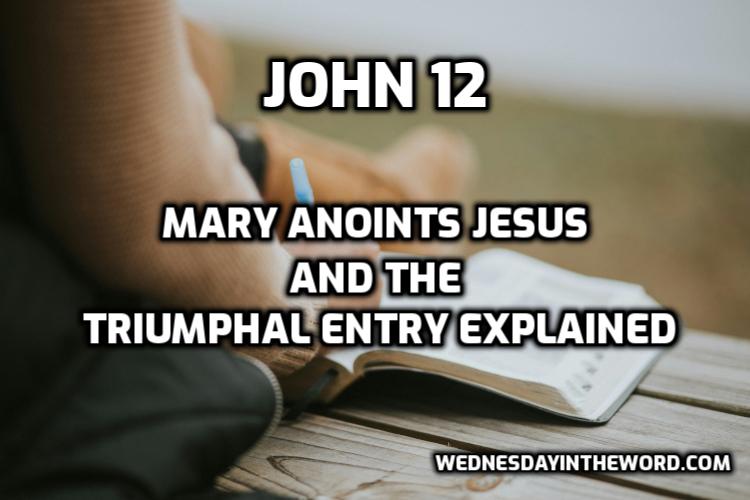Mary Anoints Jesus and the Triumphal Entry Explained (John 12)
John 12 reveals a pivotal moment where Jesus’ ministry shifts toward the cross. Mary’s devotion and the triumphal entry highlight his worthiness, while Judas and the crowd expose the complexity of belief. Jesus affirms his mission: to die, rescue his people, and glorify the Father.
Mary Anoints Jesus at Bethany
John 12 opens with a dinner in Bethany, six days before Passover, where Jesus is honored after raising Lazarus. Mary, Martha, and Lazarus are present. Mary anoints Jesus’ feet with costly perfume, wiping them with her hair. This act stands in stark contrast to Judas’ reaction.
- Setting and Context: Jesus attends a dinner at Simon the Leper’s home in Bethany, where Lazarus, recently raised, reclines with him. John names Mary, Martha, and Lazarus as key figures, likely safe to mention years later when he wrote, unlike earlier Gospels.
- Mary’s Act of Devotion: Mary uses a pound of expensive perfume—possibly her dowry—and her hair to anoint Jesus’ feet, symbolizing deep loyalty. This reflects cultural hospitality rituals and her humility, akin to a servant’s task.
- Judas’ Objection: Judas Iscariot, soon to betray Jesus, protests that the ointment could have been sold for 300 denarii (a year’s wage) to help the poor. John reveals Judas’ true motive: he stole from the moneybag he managed.
- Jesus’ Response: Jesus defends Mary, linking her act to his burial. This foreshadows his death and underscores the urgency of devotion to him now.
- Belief vs. Unbelief: Mary’s faith contrasts with Judas’ unbelief. Despite equal exposure to Jesus’ teachings and miracles, Mary believes and serves, while Judas plots betrayal, illustrating John’s theme that belief is a choice.
The Triumphal Entry into Jerusalem
The second story in John 12 is Jesus’ entry into Jerusalem, greeted by crowds waving palm branches. This public moment affirms his identity as king, but not in the way they expect.
- Crowd’s Reaction: After Lazarus’ raising, large crowds gather to see Jesus and Lazarus during Passover. They welcome Jesus with palm branches—a symbol of military victory—shouting “Hosanna! Blessed is he who comes in the name of the Lord, the King of Israel!”
- Jesus’ Symbolic Choice: Jesus rides a donkey, fulfilling Zechariah’s prophecy of a peaceful king, not a military conqueror on a warhorse. The disciples only grasp this significance after his resurrection.
- Pharisees’ Desperation: The Pharisees, alarmed by Jesus’ growing following, say, “The world has gone after him,” intensifying their plot to kill him and Lazarus.
- Temporary Belief: The crowd’s enthusiasm, fueled by Lazarus’ miracle, is fleeting. Many who shout “Hosanna” later demand Jesus’ death, showing that emotional reactions to miracles don’t guarantee lasting faith.
The Greeks Seek Jesus and His Final Teachings
As Jesus’ public ministry nears its end, Gentiles seek him, and he reflects on his coming death and its purpose.
- Greeks’ Request: Some Greeks, likely God-fearers, ask Philip to see Jesus, hinting at his future appeal to all people. John doesn’t say if they meet, possibly to set up Jesus’ next words.
- Jesus’ Hour Arrives: Jesus declares, “The hour has come for the Son of Man to be glorified,” comparing his death to a grain of wheat dying to bear fruit. He urges followers to prioritize eternal life over worldly gain.
- Divine Confirmation: Troubled yet resolute, Jesus prays, “Father, glorify your name.” A voice from heaven affirms, “I have glorified it, and I will glorify it again,” strengthening the crowd’s witness, not Jesus’ resolve.
- Judgment and Salvation: Jesus says his death will judge the world, cast out its ruler (Satan), and draw all people to him. The crowd questions how the Christ can die, prompting Jesus to urge belief in the light (himself) before it’s gone.
- Unbelief Persists: Despite signs, many reject Jesus, fulfilling Isaiah’s prophecy of spiritual blindness. Yet some authorities believe secretly, fearing the Pharisees. Jesus concludes that belief in him is belief in the Father, and rejection brings judgment by his words.
John 12 Key Themes
John 12 weaves together recurring themes from the Gospel, preparing us for the cross:
- Belief and Unbelief: Mary believes, Judas and the Pharisees don’t, and the crowd wavers—showing faith requires perseverance and divine intervention.
- Jesus’ Identity: Signs like Lazarus’ raising and the triumphal entry affirm Jesus as the Messiah, but he redefines kingship as the king who came to bring peace by giving his own life.
- Eternal Life: Jesus’ death is the path to eternal life for those who follow, a cornerstone of John’s message.
Please listen to the podcast for more detail and explanation.
Next: 23 The Upper Room Discourse: Jesus’ Final Teaching (John 13-17)
Previous: 21 Why Jesus Delayed Raising Lazarus (John 11)
Series: Gospel of John: Believe and Find Life
Study: Gospel of John Bible Study Resources
Podcast season 25, episode 22
Page Views: 499
